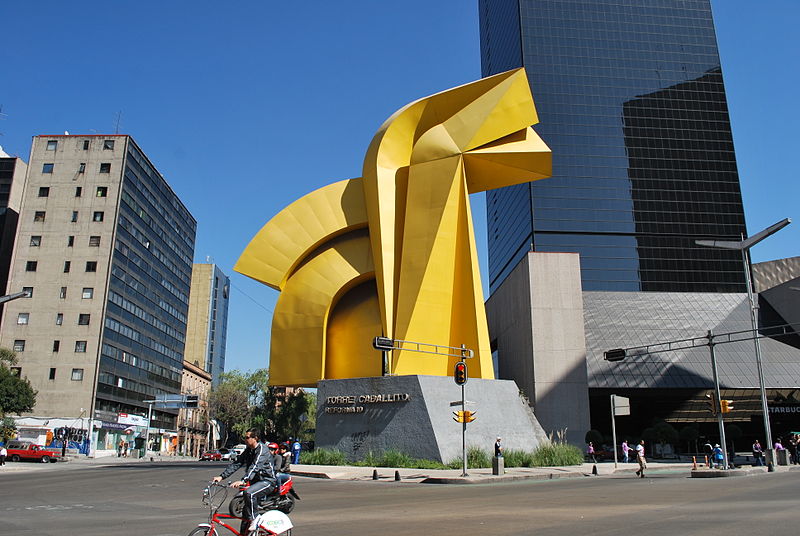
Sebastián’s “Caballito” needs to be understood in relation to the original “El Caballito.” That equestrian statue, stood at this very location from 1852 until 1979 when it was moved to the Manuel Tolsá Plaza in front of the MUNAL National Art Museum.
The artist, Sebastián, titled the work “Cabeza de caballo,” meaning “Head of a horse.” It’s known to everyone, still, as “El Caballito,” even long after the original was moved. The work rather obviously starts with Tolsá’s Charles IV, and from there it may just go where you’d like it to. People have never stopped arguing about it.
The Glorieta, that is, the traffic roundabout, is the seventh of the Glorietas of the Paseo de la Reforma (when traveling west to east). It actually predates the Paseo by more than a decade. It’s first mentioned, as a roundabout on Bucareli, to the south, in 1852.
Although some of the polish has worn off of the Avenida Bucareli in the years since it was laid out, it remains a grand street. Antonio María de Bucareli y Ursúa was not the only Italian to have been Viceroy. His 1778 street, though, would come to be one of the finest. Certainly the intersection with Paseo de la Reforma was a prominent thoroughfare, and remains one today.
The statue is made from steel plates coated in a brilliant yellow enamel. This Caballito is 28 meters (92 ft) tall. The owners of the tower behind the sculpture, the Torre El Caballito, commissioned the work. Their requirements specified that it be 28 meters in height and capable of venting the fumes from a sewer underneath. It’s succeeded at these modest goals. And it has been an important point of reference ever since
Sebastián, the artist, is Enrique Carbajal González. Born and raised in Chihuahua, his work is always vaguely related to the north of the country. Steel sculptures, they always retain a whiff of the desert. The truth is, Sebastián spent his student years in Mexico City and has essentially been here since he began his studies at UNAM in 1964. His work is among the most recognizable visual art to have emerged in Mexico in the latter half of the 20th century.
Monumental, modern, and outspoken, Sebastián’s work graces the horizons of a good dozen Mexican cities. They’re nearly aways highly stylized monochrome abstractions based in natural forms. Two of the closest are Coyote Hambriento, in the center of Ciudad Nezahualcóyotl, in Mexico State. The title refers to one way of translating Nezahualcóyotl’s name, i.e.; Hungry Coyote. The Fluorita Roja (Red fluorite) is even closer, on the UAM campus in Azcapotzalco.
They’re controversial in a rather harmless way almost everywhere. Big, modernist metal sculpture might always throw some people into a frenzy. But Sebastián’s “Caballito”, alas a riderless horse, pulls off an entirely appropriate feat. It’s respectful of its past while correcting a few of the past’s own indiscretions. There are no conquered indigenous, and no foreign king here. In fact, Sebastián claims to have followed the Olmec sense of proportion, considering only the size and shape of the horse’s head. The result is sometimes startling. At almost 40 years, the work is aging exceptionally well.
Sources cited on this page:
El Caballito on Mexican Routes

Nearest at 0.02 kms.

Nearest at 0.06 kms.

Nearest at 0.28 kms.


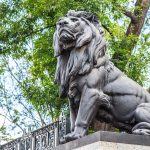
A main entrance to Chapultepec park, flanked by historic lions...
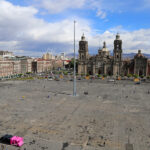
There's no center like the very center, and in Mexico City, that means el Zócalo!
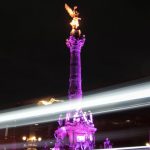
Likely the most prominent symbol of Mexico City, El Ángel is always at the center of things...
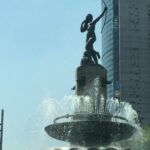
One of Reforma's most striking "glorietas," the Diana is more than a copy of some Euro original. It's homegrown!